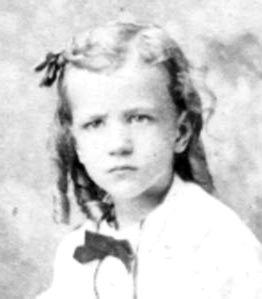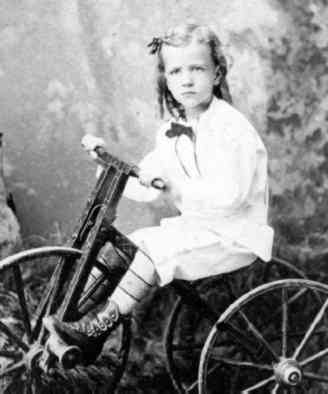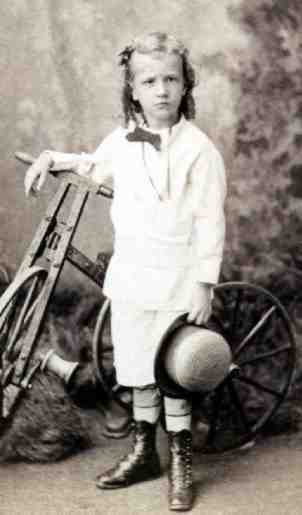
American Boyhood: Joseph C. Breckinridge Jr. (The 1870s)
|
Family
The Brechinridge family is one of the most illustrious in Kentucky.
Its members include John Cabell Breckinridge (1821-75)
who was James Bucanan's Vice
President. He ran unsuccesfully for President in 1860 and in fact his
southern campaign split the national Democratic Party and guaranteed
Lincoln's election. After his
defeat by Lincoln joined the Confederacy and served in many of the
major battles of the Civil War from Shiloh to the Shenandoah Canpaign and
Cold Harbor.
A nephew of Vice President Breckinridge, Joseph Cabell Breckinridge
(1842-1920), was a Major General, but fought for the Union in the
Civil War. His father, a minister, was one of the most distinguished devines and one of
the most prolific writers of the century; a leader of the Kentucky
emancipation party in 1849; and a strong Union man in 1861 at the outbreak
of the Civil War. He fought at many major battles, including some that his
uncle fought in. He was promoted to major for service with Sherman
before Atlanta. He stayed in the Army after the War and became Inspector General in 1888.
He was promoted to Major General in the Spanish-American War. Tragically
his son Joseph was killed in the events leading up to the war.
Gen. Breckinridge was married to Louise Ludlow of
Lexington, Kentucky in July of 1868. Their first son, the boy in the
photograph, was Joseph Cabell Breckinridge Jr. born in February, 1872.
Joseph Jr.
Joseph was born in 1872. He was photographed in July 1876 at the age of 4 years, 4 months old.
|
Joseph wears a rather ordinray kneepants outfit with a kind of short back-buttoning tunic top. He has stockings with a destinctive horizontal stripe, with alternating colors. He has interesting style shoes and wears a bow tie. His hair is is worn in long ringlets. The front hair which looks to be short, but also too long for bangs, is braided to side of his head and tied with a hair ribbon. The hair braiding is interesting. Is his mother letting his bangs grow out?
In the photograph he is wearing something around his neck which is tucked
in his brest pocket. This may be a locket, or more likely for a boy a
pocket watch which is worn on a chain around his neck.
I wish
the picture was better but it is yellow in color. I don't know if the
tricycle is his or belongs to the photographer and is use as a prop for
children's photographs.
Joseph doesn't look very happy about being photographed. In fact he
looks about ready to cry. One has to ask why. Getting photographed was
a bit of an event. His clothes seem rather boyish and should not have upset it.
Nor would he be upset about having the opportunity to play with the trike.
He might not have been to wild about his ringlet curls, but they were
obviously not anything different as he had grown them over time. The
only thing which may have upset him would be the hair bow. I do not
kmow if he wore hairbows every day. Probably not. It is likely that
his mother would have only tied on a hairbow for special occasions. And
of course a formal photograph was just such an event. Probably Joseph
did not like the idea. I would be interesting to know for just what
occasions the hairbow would be deemed approprite--church? parties? park
outings? trips? ect.
A HBC contributor cautions that many observers of old photographs note how "unhappy" the child appears to be and attempts to draw some particular conclusion because of it... often it seems whenever the boys happens to be wearing something they feel is unusual, like a dress. The problem is that, as you've pointed out, having your photograph taken was in itself an unusual event. It was also not really a very pleasant one in the old days. Because of the relative slow film speeds involved, the subject had to hold still for a very long time in order to prevent a blurred pic. For a child, I would imagine that this would quickly become unendurable, especially if several photos were taken during the session ... which was probably the case. In fact, although I have no evidence of it, I suspect many photographers specifically told their subject NOT to smile in that it's difficult to hold a smile for the amount of time involved in taking a photograph. This was probably less true by the 1890s as better films were developed, but these photographs of Joseph were aken in 1876. Even so, I think he does look rather uphappy, more so than boys in most photographs. Unfortunately no real details are involved.
|
Mother
Joseph mother clearly liked ringlet curls and she has carefully styled
his hair. She chose ringlet curls a decade before the publication of Little Lord Fauntleroy popularized the hair style. She was also one of those mothers who thought it appropriate to breech her son well before she was willing to clip his curls. Many other mothers chose to cut their boy's curls before
breeching. Joseph actually at age 4 seems to have been breeched at a relatively young age, 5 years was probably a more common age. Joseph's mother, however, was not about to
clip his curls, but even added the
hairbow for a little color and flare. This may have in part been because boys clothes in the 1870s were more plain than was the case in the 1880s when velvet
Little Lord Fauntleroy suits and
lace collars became popular for boys, even boys
much older than Joseph.
Hair bows for boys seem to have been much more common in France than America. French mothers did not curl boys' hair in ringlets as commonly as in America and the hair bows were used to keep the long hair in place. Old photographs show that most American boys kept in
ringlet curls did not have hairbows. Almost asuredly if mothers used hairbows they would have insisted they be included in the photographs. While not common, clearly some American brothers liked the combination of ringlet curls and hairbows. It is unlikely that their
sons shared their enthusiasm.
Adult Life
Ensign J. C. Breckinridge Jr. met a tragic death in Havana Harbor in Feb. 1898 when his torpedo boat, the Cushing, was sunk while delivering dispatches to the battleship, Maine. Joseph was was 26 years old.
HBC
Return to related pages:
[English boys clothes]
[Ringlet curls]
[Bangs]
[Main Fauntleroy page]
[Vivian Burnett]
[Kilts]
[Dresses]
[Long stockings]
[Lace collar]
[The 1870s]
[Strap shoes]
[Eton suits]
[Sailor hats]
Navigate the Boys' Historical Clothing Web Site:
[Return to the Main Bio A-F page]
[About Us]
[Introduction]
[Activities]
[Biographies]
[Chronology]
[Cloth and textiles]
[Countries]
[Garments]
[Girls]
[Photography]
[Topics]
[Bibliographies]
[Contributions]
[FAQs]
[Glossaries]
[Images]
[Links]
[Registration]
[Search]
[Tools]
[Boys' Clothing Home]
Created: November 30, 1998
Last updated: November 30, 1998




